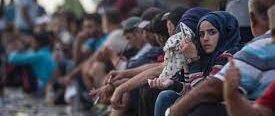Refugees and the Risk of Sexual Violence
Dr. Marian Tankink, Medical Anthropologist and Independent Consultant, specialised in Research and Training on Gender, Violence, Peacebuilding and Mental Health.
Sexual violence (SV) includes all types of (sexual) acts involving violence, coercion, trafficking or harming a person’s sexual identity, regardless of the relationship with the victim (WHO, 2002). SV is not limited to physical penetration of the human body; there need not even be physical contact. SV occurs both in peacetime and during conflict and is considered one of the most disruptive and traumatising human rights violations (Lindsey, 2000).
There are many causes of SV among refugees. Firstly, conflict weakens the legal and security institutions present in countries of origin and the availability of weapons violence increases in general (Scott et al., 2013). Moreover, SV can be used as a strategic tool to gain power and dominance over a group considered inferior. Structural gender inequality and cultural norms regarding LGBTQIA+ people mean that women and people who do not fall within existing cultural (sexual) norms are more at risk of SV.
During flight, refugees are exposed to increased risks of SV, physically, psychologically and sexually. Dependent on traffickers, refugees lack protection from their family as well as the required social, medical, psychological and legal support. Sexual exploitation is a constant risk. Often they are also not sufficiently protected and supported by the governments of the countries through which they transit. Sometimes the risks are known in advance. For example, some families in Eritrea wanted their girls to be injected with contraceptives before they left the country; the risk of SV was assessed as unavoidable so protection against pregnancy was all that could be done.
In the countries where asylum is sought and where people are supposedly given reception and protection. In most places, the quality of reception and protection is not sufficient to prevent SV.
Prevalence
There is a lack of qualitative, quantitative and comparative research about the prevalence of SV, partly because most people remain silent about their experience. What is known, is that over half (57%) of people who came to Europe in 2018 experienced violence related to their gender, 69% of whom were women and 29% of whom were men, 2% did not specify their gender (De Schrijver et al., 2018). Unaccompanied children are particularly at risk (UNHCR & UNICEF, 2019).
For a long time, ‘gender-based violence’ and ‘violence against women’ have become synonymous in many UN, legal and other policy documents, in academic texts and as used by NGOs. However, gender-based violence necessarily includes men, boys and people from the LGBTQIA+ community. Unfortunately, even fewer figures are available on the prevalence of gender-based violence against those groups. UNHCR estimates that 30-40% of male refugees from Syria have experienced SV (Chynoweth et al.,2017). In a German study, 36.6% of male refugees interviewed reported having experienced SV (Nesterko et al.,2022). People from the LGBTQIA+ community and people with disabilities are particularly vulnerable (Nesterko et al.,2022).
Among refugees, all gender and age groups are potential victims of SV, not only girls and women. This ratio is different from the host population. Also, the distinction between ‘perpetrator’ and ‘survivor’ is not as black and white as is often assumed (Araujo et al., 2019). Someone may have been coerced into sexual acts, for example, and therefore be both perpetrator and victim at the same time.
SV during flight is usually accompanied by other forms of violence and human rights violations. Keygnaert (2014) reports that of 154 refugees interviewed from sub-Saharan Africa, 90% reported multiple forms of victimisation, a total of 548. Half (45%) were forms of SV, mainly gang rape or having to watch family members or fellow refugees being victimised. It is worth remembering that any psychological symptoms may also be related to other traumatic experiences and may not only be linked to SV experiences. Especially during flight, but also in the countries where refugees seek asylum, there is often insufficient legal, medical and/or psychological help.
Many refugees feel that if they speak out, they might be ostracised by others. A sense of safety and viability requires a sense of belonging to others. Therefore, it is important to ask all refugees whether they have experienced sexual violence, regardless of gender and age. In treatment, the most important and difficult task is building trust. When psychological treatment is necessary and made available, refugee clients must develop a form of agency that enables them to expose themselves to their therapists. Only then it is possible to be vulnerable and recount the events in which they have been subjected to sexual violence. Furthermore, attention must be paid to the nature of the person’s interpersonal relationships. Feeling rooted and having a sense of belonging is possibly the most important (and least recognised) need of human beings (Weil in Jackson 2006, p. 12). This is why survivors keep their experiences private. However, by doing so they are simultaneously deprived of something else that is essential to life, namely being heard and being recognised by others in their community (Arendt, 1998; Jackson, 2006).
References
- Araujo JO, Souza FM, Proença R, Bastos ML, Trajman A, Faerstein E. Prevalence of sexual violence among refugees: a systematic review. Rev Saude Publica. 2019;53:78.
- Arendt, H. (1998) [1958]. The human condition: Second edition. Chicago: University Chicago Press.
- De Schrijver, L., Vander Beken, T., Krahé, B., & Keygnaert, I. (2018). Prevalence of sexual violence in migrants, applicants for international protection, and refugees in Europe: A critical interpretive synthesis of the evidence, International Journal of Environment and Public Health, 15(1979); doi:10.3390/ijerph15091979
- Jackson, M. (2006). The Politics of storytelling: Violence, transgression, and intersubjectivity. Copenhagen: Museum Tusculanum Press.
- Keygnaert, I. (2014). Sexual violence and sexual health in refugees, asylum seekers and undocumented migrants in Europe and the European Neighbourhood: determinants and desirable prevention. Ghent University.
- Lindsey, C. (2000). Women and war. International Review of the Red Cross, 839,561-579
Nesterko, Y., Schönenberg, K.H., & Glaesmer, H. (2022).Mental health of recently arrived male refugees in Germany reporting sexual violence, Medicine, Conflict and Survival, DOI: 10.1080/13623699.2022.2151742 - United Nations High Commissioner for Refugees (UNHCR), United Nations International Children’s Emergency Fund (UNICEF) and International Organisation for Migration (IOM), (2019)., Refugee and Migrant Children in Europe. Overview of Trends January-December 2018, UNHCR, UNICEF and IOM.
- Weil, S. (1952). The Need for roots: Prelude to a declaration of duties towards mankind. London: Routledge.
- World Health Organization., World report on violence and health (Geneva: World Health Organization, 2002), Chapter 6, pp. 149.

